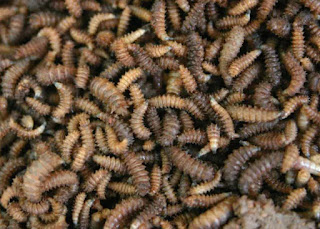A Good Way to Feed Catfish
In
catfish farming or any other type of fish farming, feeding is one of the most
important things. Some people may think that feed catfish is simply throwing the feed to the pool, but it that
is not true. Although it may seem easy and simple, there are many things to be
considered if you want the catfish to grow well and thriving.


1.
Size
of feed
In
general, catfish feeding should be based
on how old or how big your catfishes are. There are many sizes of catfish feed
available, so it shouldn’t be too hard to find one that suitable with your
catfish size. When the catfish get bigger, you can feed them with bigger food size.
When
you are able to grow really big fishes, for example when your catfishes reach 1
kg in weight or more, you can consider the 8 or 10 mmm feed sizes. It will be
more practical and easier to feed, but if you cannot find a bigger feed, the
regular one should be fine.
2.
Feeding
frequency
Just
like how the feed size matters in feeding the fish, you should also pay
attention to how often you feed them. Different stages of growth require a different
frequency of feeding too. Fingerlings of 3-4 grams weight should be fed twice
per day. When they reach the post-fingerlings and juvenile stage, you can keep
feeding them twice a day or reduce it to once a day. Next, after they reach the
post-juvenile or above that, you can reduce the feeding frequency to once a
day.
3.
Types
of catfish feed
What do catfish eat is
a common question to ask for a beginner in fish farming. Basically, you can get
any type of catfish feed on any fish store around your area. Some bigger store even has organic fish food that is good for your
fish’s growth. Give your catfish an adequate amount of protein to keep them
growing well.
Aside
from different sizes, there are also floating feed and sinking feed. The floating
feed is those that keep floating after you spread them in water, while the
sinking feed is those that immediately sink after you throw them into the water.
The floating one is good for the smaller size of fishes like the fingerlings or
juveniles stage. While the sinking one is better for bigger fish as they are
naturally bottom feeder.
4.
Catfish
nutrition
To
yield good production for the harvest, you need to pay attention to the
nutrition you give to the fishes. While ready to fed catfish feed is usually
packed with nutrition, you can also give them more natural feed like duckweed,
for example. Duckweed is known as great fish feed and is commonly incorporated
in fish farming. But how much duckweed
to feed catfish is good enough?
Duckweed
has been known for its high nutrition content. It also contains a high
concentration of amino acids, methionine, and lysine which is good for the
growth of the fishes. You can feed them with
duckweed as an alternative source of food for them.
5.
How
much do you feed the catfish?
The
portion is also things to consider when you feed catfish. It is obvious that lack of feeding will hinder the
growth of your catfishes and may make them appear smaller than the size they
should be in respect of their age. Additionally, you should also be careful not
to overfeed them. However, understanding
whether your catfish is already satiated may not be easy for beginner catfish
farmers.
To
understand whether your fishes are well-fed or not, you have to observe them
carefully. When you are using the floating feed type, it should be easier
because you only have to make sure that there is no excess feed on the surface
of the water. Floating feeding should be finished within 5 minutes after you
stopped feeding the fishes. When it is more than that, it will be probably just
going to be a waste and you should not add more feed.
For
the sinking feed type, you need to observe the response that your fishes have.
When they respond actively and eagerly when you feed catfish, it’s most definitely that they are hungry. When the
reaction reduced and they become calm, it means that they start to feel full.
Another sign is that the fishes are not popping their heads out of the water.
Every
fish farmers need a proper knowledge on how to feed catfish. It goes beyond spreading the fishes feed only, but
also considering their nutritional needs and the surrounding conditions. Well-fed
and stress-free catfishes will be able to grow healthily and thrive. This will
result in good production results which will lead to profitable business for
catfish farmers.
Comments
Post a Comment